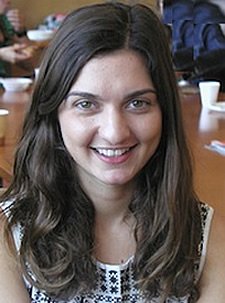Blinding Us With Neuroscience
Sheila Shahidzadeh is a world-traveler who’s right at home in the lab

Sheila Shahidzadeh is a master’s student in biology, with an interest in, among other things, cell signaling. In June, she was one of 12 people invited to travel to Paris, France, to participate in a workshop on surgical techniques, co-sponsored by The Jackson Laboratory and The Pierre-and-Marie-Curie University. The opportunity combined some of Shahidzadeh’s favorite things: science, laboratory research, and French language and culture.
Shahidzadeh is based in the lab of Dr. Sandra Hewett (the College’s Beverly Petterson Bishop Professor of Neuroscience) and is co-mentored by associate professor of biology Dr. Jim Hewett as she studies epilepsy and the seizures caused by this crippling disease. The College’s Laura Bulman caught up with the former biopsychology major to discuss her burgeoning career.
1. How did you become interested in neuroscience?
I’ve always loved biology, but it wasn't until my sophomore year of college [The University of California, Santa Barbara], when I took my first neuroscience class, that I absolutely fell in love with it. Until then, I was more of a humanities and social sciences person. I was a dancer my entire childhood and also loved to read and write. Those interests led me to believe I was more of a creative and artistic person than a hard-sciences type of person. Little did I realize how related these two fields are. Creativity is imperative, when it comes to science.
2. Why did you choose Syracuse University?
I chose Syracuse University because the biology graduate program seemed like a perfect fit for me. I wanted to get a taste of working in the lab all day, every day, over the course of my entire program. After learning about my lab's current research and meeting my advisor, Dr. Sandra Hewett, I knew that joining her lab would be a smart decision and that I would get a lot of experience.
3. What’s it been like so far?
My favorite thing about the biology department is that we get to interact with faculty members every day. The department is the perfect size, and I enjoy getting personal feedback, whether in the classroom or the lab, that is helping me grow. This supportive environment is shaping the way I think, critically, as a researcher.
4. How did you become interested in epilepsy?
Epilepsy affects more than 65 million people worldwide. In the United States alone, one in 26 people will develop epilepsy over the course of his or her lifetime. However, one-third of epileptics are resistant to available treatments. In targeting a protein [system xc-] that transports glutamate into the extracellular space, the long-term goal of my project is to develop a therapeutic target for epileptics to turn to when other anti-seizure medications fail to work. Every patient is different, and, by controlling the release of glutamate via system xc-, we may be successful in decreasing an epileptic’s susceptibility to seizures.
5. What are some other things of which you’re proud?
I am most proud of having lived abroad twice. The first time was in an immersion program in Lyon, where all my classes—including ones in neuroscience—were in French. This instilled in me a desire to travel, so I decided to live abroad during my gap year [between graduate and undergraduate studies] to teach English and volunteer in a laboratory in Paris. I try to travel as much as possible, be it a day trip in Skaneateles or backpacking across South America.
One of my favorite things about Syracuse University is its close proximity to a number of places in the Northeast and Canada that I’ve always wanted to see. So far, I've been able to visit a couple and hope to see a few more in the near future.
6. Future plans?
I would like to earn my Ph.D. and work in either academia or industry. I have yet to decide my exact path, but what I do know is that it will revolve around neuroscience.
Media Contact
Laura Bulman
